Last day of fun at SaltCon 2016 – Day 3
After a couple great days at SaltCon, I was looking forward to one final day of fun. That’s why before ending Day 2, I scheduled to start playing again at 8:00 am Saturday with Quince and Adam.

So with just a few hours of sleep, I was happily diving back into action before the main gaming hall opened.
Knowing it was the final day of SaltCon, I had to make the most of the day playing games at the top of my want-to-play list. And there were still many people I was hoping to meeting up with before the end of the con. It would be a busy and fun day!
In addition to the game mini-reviews today, I’ll also share a bit about some of the other fun things that happened at SaltCon such as the Math Trade, Game Swap, Social Games, RPG room, and Painting Miniatures. I’ll also share some tips for those interested in going to a board game convention.
Now, on to the mini-reviews of the final 9 games I played at SaltCon 2016.
If you’d like to jump to a particular game, click on the name in this list:
- Cities
- Gravwell
- Stockpile
- Camel Up
- Abyss
- Infinite City
- Between Two Cities
- Empires at Sea
- Deception: Murder in Hong Kong
19. Cities
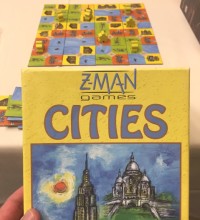
When I arrived back at the convention center just after 8:00 am there were a handful of people milling about. Since I had arrange to meet Adam and Quince at 8, I was on the lookout. I came across Adam in the room just next to the not-yet-opened gaming hall.
He had stayed up all night gaming and was still wide awake and playing another game I’d never heard of before — Cities (Z-Man games 2008).
When I saw it was a tile-laying game, I was immediately drawn in since I love tile-laying games.
It’s a quick game to play. And since Quince wasn’t around yet, I joined Adam and two others in an introductory game of Cities.
In Cities every player constructs their own city and competes on points for who builds the best city.
Each tile is numbered and is played simultaneously. So one player randomly draws a tile from their personal stack of tiles and calls out the number on that tile and then places it in their city. The other players then find that same numbered tile in their own set of tiles and place it in their own city.
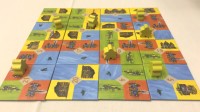
Each tile is divided into 4 sections or fields of different color combinations. The colors are yellow (attraction), red (terrace), green (park), and blue (water). So a tile may have two fields of green, one green, and one blue for example.
When placing a tile, it must be placed adjacent to an existing tile but the colors do not need to match up.
However, since much of the scoring is based on the size of certain areas (like parks and attractions), players will want to structure their city in such a way to create large continuous areas of those colors.
I won’t go over the specific scoring, but a key part is that only areas with a meeple/tourist on them will score at the end of the game. So when placing a tile, the player may choose to place one of their 7 meeples on a field on that tile. There are also rules in being able to move already placed meeples, but you get the point – good placement of meeples is just as important as good placement of tiles.
While there are 24 tiles in each set, a city is complete once 16 tiles are placed (4 x 4 grid limit). So if you’re holding out to get the perfect tile to fill in gaps, you may be out of luck because it might not even come up that game.
Since it’s simultaneous play in building cities, the game goes very quickly.
And I really enjoyed it!
It’s simple, gets the brain churning just a bit, and can be enjoyed by all ages.
And at less than $15, it looks like a great family game to have around. I may have to pick this one up.
20. Gravwell
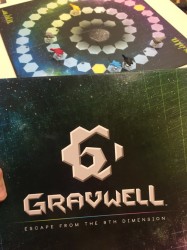
Another game Adam brought to SaltCon was actually a game I introduced him to when we first met at SaltCon two years ago — Gravwell (Cryptozoic Entertainment 2013).
We had recently reviewed Gravwell and I thought it would be a good game to take with me to the con to introduce to others. As I thought, it turned out to be a hit with those I played it with and many left saying they were going to buy a copy.
It was great to see that Adam had done just that and bought a copy for his own game collection.
So it felt a bit like full-circle to sit down and play his copy of Gravwell.
If you haven’t seen our review of Gravwell, I highly recommend you check it out. I still really enjoy it.
21. Stockpile
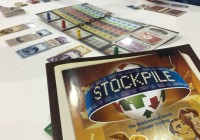
While we were playing Gravwell, Quince arrived with our next game to play in hand — Stockpile (Nauvoo Games 2015). So while we finished our game, Quince headed to the main gaming hall to grab a table and set up the game.
I first heard about Stockpile from the game’s designer, Seth Van Orden early 2015 prior to their Kickstarter project to publish the game.
We touched base again a few months ago and I found that although Seth wouldn’t be able to be at SaltCon, his brother would — who could show me the game. Well, it turns out that his brother is Quince, who I had met at a previous SaltCon.
So now was my chance.
We pulled in a couple other players for a 5-player game of Stockpile.
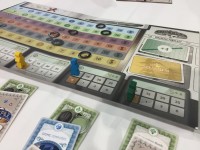
In Stockpile players act as stock market investors — buying and selling stock as the value fluctuates.
There are a number of the things I enjoyed about Stockpile. The first is that at the start of each round, each player gets insider information on what’s going to happen to the value of a particular stock. So when they’re bidding on shares, they have a bit of information on what’s coming.
Another thing that’s cool is that shares are claimed through auctions. Players place 2 cards into the auction blocks to be bid on. One card needs to be face-up and the other face-down. So during the auction phase, players can see some of the cards they’ll be getting, but not all. So there’s a bit of a guessing game on what they’ll end up with.
Players then are faced with the choice of selling or holding on to their shares before the market forces change the value.
While the production value isn’t the greatest, the game was fun to play.
22. Camel Up
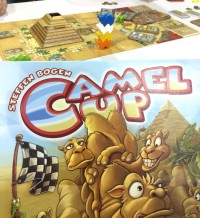
After wrapping up Stockpile, I needed to take a break to stretch my legs and get some fresh air. So I spent a bit of time just walking around outside and then checking out some of the other happenings at SaltCon (see below the game mini-reviews).
I then dove back into the Game Library looking for other games I had on my want-to-play list. The game I ended up walking out with was one I’d heard about for a while as being a great family game — Camel Up (Z-Man Game / Pegasus Spiele 2014)
I’ll just cut to the chase and let you know that I agree with what I’d heard — Camel Up is a very good family board game.
In Camel Up players are betting on a camel race. Now, doesn’t that just sound like great family fun?
Ok, so the betting is really benign.
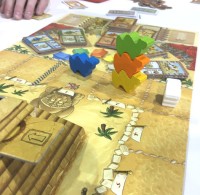
What’s really going on in Camel Up is that a bunch of colored camels are moving around the board (race track) based on dice rolls and special actions. Players each have a set of cards representing each colored camel and can secretly place those cards onto the betting areas — one area for which camel they think will come in first and one area for which will come in last.
The players that put their cards in earlier (and are correct) will get more points.
But players also gain points during the race by claiming tiles that represent the different camels and who will be in the lead at the end of each round.
So while it may be referred to as “betting” it sure doesn’t feel like that during game play. It’s more about guessing on what will happen. (It reminded me a lot of a similar game I really enjoy playing — Lemming Mafia — where players guess on which order the lemmings will end up.)
Yet, the coolest part is how the camels move.
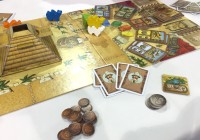
As you can see in the photos, the camels stack on top of each other as they race along. When tied on spots in this manner, the one on top is in the lead.
But that’s only part of the movement. The other part is hidden in the pyramid!
Inside the pyramid are colored dice that represent the camels. When a player chooses to move a camel, they shake the pyramid, turn it upside down, and then release one die with this cool contraption of a pyramid. This way, they don’t know beforehand which camel is even going to move or how far.
Of course, each camel can only move once per round. So when a camel’s die is used, it’s set aside until all camels have moved once that round.
All in all, I had a great time playing Camel Up with Dan, Adam, and Leo. I can easily see my family having a great time playing it as well.
See our full review of Camel Up.
23. Abyss
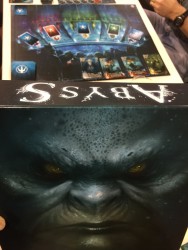
After finishing our game of Camel Up, we dove into another game near the top of my want-to-play list — Abyss (Asmodee 2014).
I had actually hoped to get a copy of Abyss in the SaltCon Math Trade, but it didn’t turn out that way. There were a couple of copies up for trade and both of them went to others. However, as luck would have it, one of the copies went to Doug.
When I met up with Doug the first day of the con, I asked if we could get his newly acquired game of Abyss to the table. He was more than happy to give it go.
Since Doug hadn’t played Abyss before either, Dan and Adam said they’d be happy to teach us.
In Abyss players are vying for control in an underwater city. They do this by collecting allies and using them to recruit Lords of the Abyss, who will then grant access to different parts of the city. Players acquire cards through a draft of sorts, and the Lords of the Abyss acquired on those cards grant special powers to the cardholder.
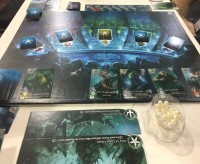
The first thing people always mention about Abyss is the artwork. It’s adored by many. And I’d concur. I really like the art style of the game. There’s no doubt that the artwork helps create the underwater atmosphere to immerse players into the theme.
But there are other cool elements of the game to love as well.
The first cool element is the unique way players acquire Ally cards. The active player flips over a card from the deck and the player to their left can choose whether to but that card. If that player chooses not to purchase it, the choice moves onto the next player and so on until it gets back to the active player. If the active player wants it, they can take it (doesn’t have to pay any cost).
If the active player doesn’t want it, then they just flip over another card and the process continues until the active player finally takes a card. Then all of the cards not taken are moved into a section of the board where cards of the same suit are piled together. So over time, as players pass on taking cards, these card piles get more and more cards.
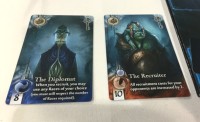
So on a player’s turn, instead of drawing cards from the deck like mentioned above, they can choose to take one of the accumulated card stacks in the middle of the board.
It’s a very cool way of getting a hand of cards.
But another cool part of this process is that when another player does choose to purchase one of the revealed cards, they have to pay the active player the cost. Thus, the currency of the game circulates among the players.
And the currency just happens to be pearls!
Doesn’t that just make sense for an underwater-themed game?
The whole point of getting a good hand of cards is that those cards are then used to claim Lords of the Abyss. These lords are larger cards that not only provide points but also grant special powers during the game.
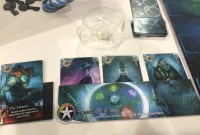
However, their powers may not last forever. Because as players progress, they’ll claim territories in the game which are then placed over 3 of their claimed lords — covering up their powers. Knowing their powers can be shut off creates interesting choices in the game of when to claim territories. The territories can provide a lot of points, but they come with that cost. Very cool.
Those aren’t the only cool things about Abyss. But they should at least gives you a taste for what’s in store.
I really liked playing Abyss!
Congrats to Doug on scoring a copy during the Math Trade. And since he really liked it as well, I know he won’t be putting it up for trade next SaltCon. I’ll have to get a copy elsewhere because it’s definitely moving to the top of my game wish list.
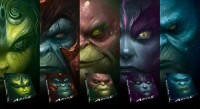
Another thing I should note is that they produced 5 different box covers for the game. So if there’s a particular box cover you really want (I’m partial to the blue one), your best bet may be to get it from your local game store. Because I’ve heard when buying from an online store it will be random which cover art you’ll get.
That being said, if online is the way you like to get your games, click here to buy a copy of Abyss.
Update 2017: See our full review of Abyss.
24. Infinite City
While we were playing Abyss, the topic of 2-player games came up and I told Dan about Longhorn. So when we finished Abyss, I played a game of Longhorn with Dan. It didn’t take long before Dan was intrigued with the game. He typically doesn’t like abstract games, but he really liked the maneuvering and scoring method in Longhorn and looks to pick up a copy of the game himself.
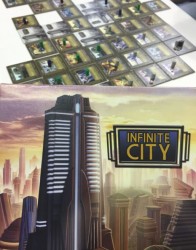
Then it was on to another new game to me — Infinite City (AEG 2009).
And wouldn’t you know it, it was yet another game Adam had brought to the con that he was hoping to play.
When he mentioned it was a tile-laying game, I was more than happy to oblige.
As he was explaining how to play, Todd walked by and quickly joined us for a 3-player game.
In Infinite City, players jointly build a sprawling city by adding building tiles along the way. Each player also has a supply of pegs of their color which will represent control of the buildings.
To start, the building tiles are mixed, five tiles are dealt to each player, and five tiles are placed face down in the shape of a cross at the center of the play area. On their turns, players play a tile face up adjacent to one of the five starting tiles or a previously played tile, play one of their colored pegs on the tile, and follow the instructions on the tile.
These instructions may lead to playing additional tiles, drawing tiles, moving tiles previously played, turning face down tiles face up, taking tiles from opponents, preventing actions or even exchanging hands of tiles with other players.
So control of the buildings is a fluid thing and players maneuver to have control over contiguous groups of tiles because that’s how they’ll score at the end of the game. Some tiles also grant points to the controlling player so those will be contested as well.
I found Infinite City to be a cool game not just because of the tile-laying aspect but also because it requires thinking through the use of the different actions tiles grant when you play them. Deciding which tile to play when and where is like a puzzle. And anticipating what the other players will do to mess with your plans creates some fun tension.
Thanks Adam for introducing me to another game I hadn’t been aware of before.
25. Between Two Cities
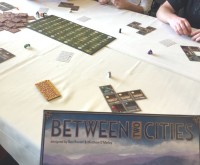
As if I hadn’t played enough city-building or tile-laying games recently, the next game I played was Between Two Cities (Stonemaier Games 2015).
It’s a game we recently reviewed and one that I really enjoy.
I also thought it would be a great game to take to SaltCon to introduce to others. And it turns out I was right. In particular, Kris was looking forward to playing it.
So after I took a gaming break to get something to eat, I found Kris and set up a game of Between Two Cities in the lobby.
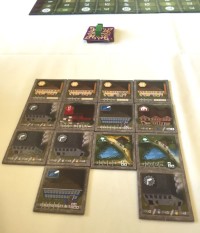
While looking for Kris, I also met Brent (host of the Meeple Nation podcast) and another couple who are familiar with our reviews and were interested in playing. As I started explaining how to play, we were also joined by John, a follower of Kris’s Player to the Left community.
So we dove into our 6-player game of Between Two Cities and watched each others’ cities develop.
In the end, Brent pulled out the win by 1 point.
If you’d like to see more, you can check out our full review of Between Two Cities.
Buy a copy of Between Two Cities.
26. Empires at Sea
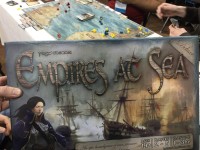
By this stage in the day, the end was in sight. Although I was far from feeling burned out, I knew there wasn’t much time left to enjoy more games. And it would come down to a couple final games that I had arranged to play before getting to SaltCon.
The first one to dive into was Empires at Sea (self-published 2015).
Empires at Sea was a game I first heard about last summer just before it’s Kickstarter campaign. When I found out the brother of the designer would have the game at SaltCon, we arranged to get in a game. We didn’t know it would take until the final night to get together, but that’s how it worked out.
It was nice to meet Joseph and learn more about the game.
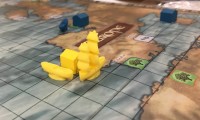
At the next table, Charles had been demoing a prototype of a game he had designed and he joined Joseph, Adam, and I to battle for control of the seas.
In Empires at Sea players take on the role of one of five nations, and work to amass the largest empire at the end of 15 rounds of play. (Or in our case, a shortened version with just 9 rounds of play.)
Each Round opens with a History Card, which hurts or helps one nation or another based on the impact of the actual historical event. A Weather Card is played, limiting or improving movement for all players for the Round (e.g., ships can only move North and East). Next, all players gain resources, based on the Ports they own, plus any Resource Cards played during the game.
Each player then takes a turn, first by playing a Captain’s Card (used to launch a ship, advance military, strengthen a port, etc.) and then by sailing their fleet to take command of new ports, trade, or attack their enemies.
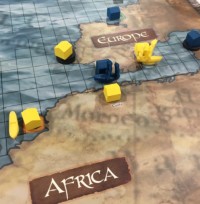
The combat system is based on a roll of the dice, plus modifiers for ship size, the weather gauge, military advancements, and Captain’s Orders.
At the end of the round, all players may bribe the Pirate. The highest bidder gets to use this pirate ship to attack the other players.
At the end of the game, players tally up their Empire score based on the ships they sunk, ships they command, ports they own, and gold and resources they’ve collected. And of course, the biggest Empire wins.
As you can see in the photos, the board and model ships are very cool and the art style is evocative of the theme.
While I’m glad I was able to play the game, it wasn’t as enticing to me as I had hoped. Perhaps it was because the weather cards drawn really limited our movement and thus our options. Or perhaps it was because we played only a condensed game. But there wasn’t as much action in the game as I had wished for. I spent most of my time just moving to establish new port areas rather than battling other players (or the pirate — which once it was defeated was out for the rest of the game).
I’m sure there’s more to the game than I experienced. So if the them interests you, check out Empires at Sea.
27. Deception: Murder in Hong Kong
To wrap up my 3 days of fun at SaltCon 2016, I was able to play another game I was really looking forward to playing — Deception: Murder in Hong Kong (Grey Fox Games 2014).
Last year one of the games I really enjoyed playing was Mysterium. So when I heard people talking about Deception being like Mysterium, I was anxious to try it out too.
One such group I’d heard about Deception from was the Meeple Nation podcast. I started listening to their podcasts a number of months ago when I found out they were right here in Utah. And they recently talked about Deception on their podcast.
So I reached out to Brent and asked if he’d teach me Deception at SaltCon.
He said he’d be happy to, but the only catch was that Deception is hard to find anywhere because it’s sold out of its print runs. Luckily though, one of the hosts (Nathan) had a copy and he’d check if he wouldn’t mind bringing it to SaltCon.
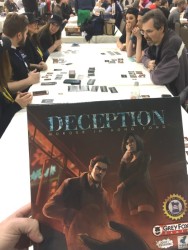
Nathan was happy to bring his copy to play at SaltCon. And Saturday night was time to get it going.
They set up the game next to the table where I was playing Empires at Sea, found a group of people, and got the game rolling. And they actually played a number of games before I was able to join in. When I was ready to play, most of those folks headed off to something else. But the Meeple Nation guys were happy to still play another round.
As luck would have it, a bunch of the gals from the H.U.G.G. (Herriman Gamer Girls) were passing by and agreed to join in the game. Matt (Mow Money designer) had also wanted to play Deception so he jumped in to play as well.
(I wish I’d taken more pictures but I was too wrapped up in playing to think about it.)
In Deception players take on the roles of investigators attempting to solve a murder case — but there’s a twist. The killer is one of the investigators! Each player’s role and team are randomly assigned at the start of play and include the unique roles of Forensic Scientist, Witness, Investigator, Murderer, and Accomplice. While the Investigators attempt to deduce the truth, the murderer’s team must deceive and mislead.
The Forensic Scientist is the one person who knows who everyone is and gives clues to the investigators.
The catch is that they can’t speak!
The Forensic Scientist can only select clues from given lists to hint at the weapon and incriminating evidence necessary to capture the killer.
Each player will have 8 cards with images in front of them. One set of 4 cards refers to the cause of death and one set refers to evidence left at the crime scene.
At the start of the game while everyone’s eyes are closed, the murdered points at one of their Cause of Death cards and one of their Evidence cards. That pairing is what the other players must guess correctly to win the game.
So the Forensic Scientist tries to give clues to help the other investigators guess those cards.
We had a big group of people playing (it will play up to 12) and it was a lot of fun. We enjoyed it so much that we just had to play a second game of it right after. And I ended up being the murderer that game while Matt was the Forensic Scientist.
Many people were pointing their finger at Adam as the murderer. So to show that he wasn’t, he used up his one accusation and pegged the exact match of my cards. I’d been caught!
But that wasn’t the end of the game.
Because we had so many players, there was also an Accomplice and a Witness in the game. My accomplice and I consulted and picked who we thought the Witness was. And since we correctly pegged the Witness, we got away and won the game.
I really enjoyed Deception: Murder in Hong Kong and look forward to the next time I’ll be able to play it again.
Deception was a great way to wrap up my SaltCon gaming!
Update: See our full review of Deception: Murder in Hong Kong.
Games Not Played
Having played a ton of fun games over a solid 3 days, I can’t really bemoan games not played. After all, 10 of the 27 games I played were games I had on my want-to-play list going in.
A number of the games I didn’t get to play were because they either weren’t available in the game library or I didn’t know anyone who brought them along. Others not played were simply due to not having more than 24 hours in a day.
Here are some games I’m still looking forward to playing:
- Mission Red Planet
- Raptor
- The Big Book of Madness
- Ultimate Warriorz
- Mystery Express
- Robinson Crusoe
- The Grizzled
- Spyfall
It’s always fun to have some games to look forward to playing.
Other Activities
During the last day at SaltCon I was also interviewed by the Discriminating Gamer crew. The Discriminating Gamer, Cody, is a board game video reviewer that does a fantastic job. I really enjoy watching his reviews and was happy to meet him a number of years ago. In fact, it was his review of Mission Red Planet that got me to put that game on my want-to-play list.
While I look forward to seeing their recap of SaltCon, I’m more looking forward to meeting up with Cody at one of his game nights.
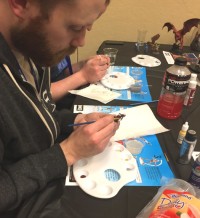
I was also planning to have an interview with the Meeple Nation podcast group for an interview, but I was so caught up in playing games I just didn’t make it during their recording. Of course, playing Deception with them was even better.
Throughout the 3 days, I also made it around to check out various other activities happening: Game Demos, Play to Win, RPGs, Giveaways, ION Awards, Prototype Alley, Tournaments, Panels, and Painting Miniatures.
Since a number of board games we have include some really cool miniatures, I think it would be great to paint them. So I swung by the painting room on Saturday and it was full of people giving it a go. There was even a painting contest that had some fantastic entries.
Hopefully this year I’ll get around to doing some miniature painting.
Game Swap and Math Trade
Another part of SaltCon that I really love is the Math Trade. If you’re not familiar with the term, a Math Trade is a computer generated way of trading games. People who would like to trade some games, enter which games they’d like to trade. Then after all games are posted, they go back in and create their wish list. In doing so, they indicated which of their games they’d be willing to trade for each game they’d like to receive.
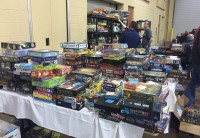
Then the computer program goes to work and figures out who should trade which game to who. It works something like this: A gives X game to B who gives Y game to C who give Z game to A. Of course it’s done on a much larger scale because of the quantity of people who participate.
I believe there were over 1,200 games in the SaltCon Math Trade this year.
People then get a list of which games they’re set to trade away and which games they’ll get in return. There’s an area set aside at SaltCon where everyone sets out those traded games (with labels of who they’re going to). So during the con I’d venture over there periodically to find the games left for me.
And I was very happy with the outcome this year. I got some great games I was hoping for.
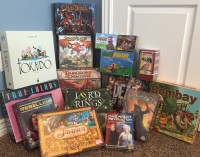
In addition to the Math Trade area, there’s also an area set aside for a Game Swap. This is where people can buy and sell used games.
For me it meant setting out all the games I put up in the Math Trade that didn’t get traded. So throughout the con, I’d get a text of someone looking to buy a game I had set out. So I’d head over to the Game Swap area to meet them and sell the game.
And on the flip side, I also bought a few games that I was excited to get as well.
With so many games on our game shelf not being played, the combination of these two ways to trade games is fantastic!
Thanks SaltCon organizers for making these options available each year!
Board Game Convention Tips
As you can see, I really enjoy going to SaltCon each year. And I’m also looking to head to the biggest board game convention in the US later this year as well — GenCon in Indianapolis.
If you’re thinking of going to a board game convention, here’s a few thing I’d suggest.
1. Plan for learning time.
Since most of the games you’ll play will be new-to-you games, you’ll have a lot of learning ahead. Don’t dive into a board game convention thinking you’ll just sit down an play every game. It can take a while to learn the rules to a new game. So make sure to allow time for the learning portion.
2. Take frequent breaks.
If you’re going to a board game convention it’s clear that you enjoy playing games. But that also means you’ll be sitting a lot. Don’t forget to get up and move. And not just from one table to the next. Get outside for some fresh air.
3. Introduce yourself.
One of the most enjoyable things about a board game convention is meeting people who share your interest. Knowing that everyone else is also there because they love games makes it really easy to start a conversation. Use that shared interest to begin to get to know others. And the best way to start a conversation is simple as just introducing yourself.
My SaltCon 2016 Favorites
As I look back on SaltCon 2016, my favorite part was definitely meeting up with people I’d met in years past and meeting new people. And through the wonder of social media, it’s easier than ever to stay in contact.
Cheers to everyone!
At the end of my Day 2 recap, I listed a few games that stood out to me the most. They’re the games that I’m most anxious to play again. And the games I played on Day 3 didn’t disappoint either — a number of them are going on the list as well.
Here’s my favorite games played at SaltCon 2016:
- Abyss
- Deception: Murder in Hong Kong
- Camel Up
- Ponzi Scheme
- Isle of Skye
- Mow Money (got a copy so I’m all set)
- Metropolys
- Cities
I can hardly wait for SaltCon 2017!

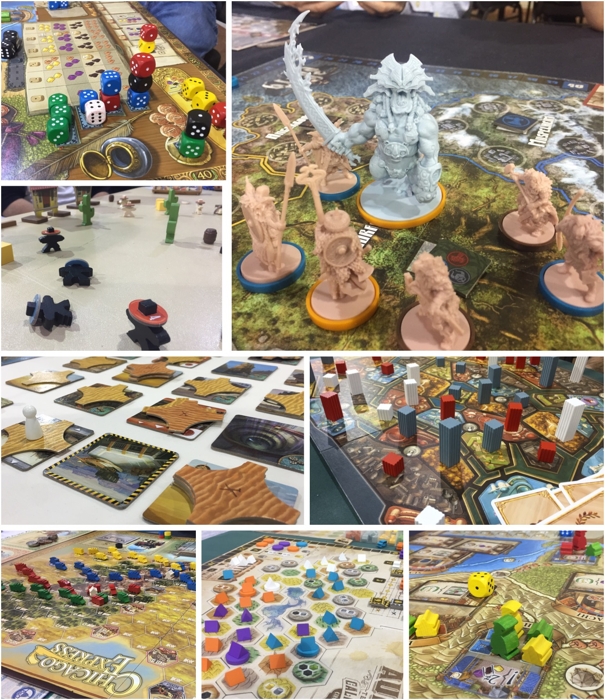
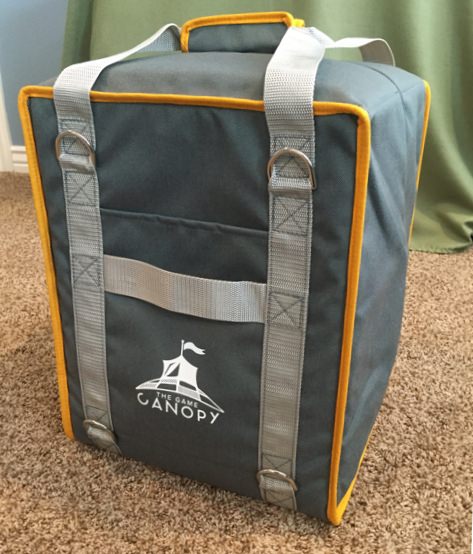
I had The Grizzled with me at SaltCon but it never came out of my bag. I wish I’d known there was someone there that wanted to play!
If I don’t get to play it before next SaltCon, I’ll still have it on my want-to-play list.
Thank you for these reviews. It gives me more insight into how to navigate a Con. We attend KublaCon in San Francisco, which is fantastic, but it is a bit overwhelming.
And, thanks to you, I have not only purchased 1 copy of Cities, but after playing it promptly bought 2 more, so that I can use it in a Games class I facilitate.